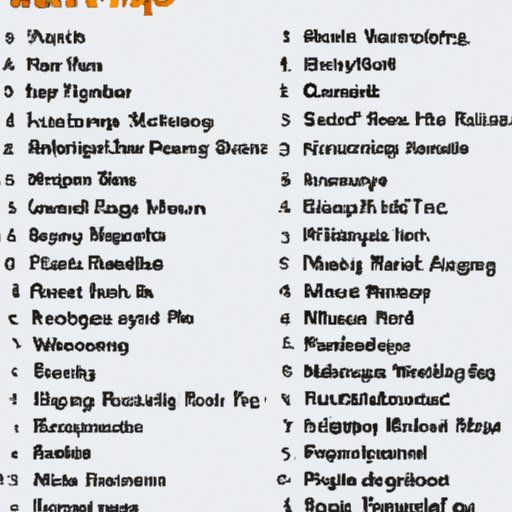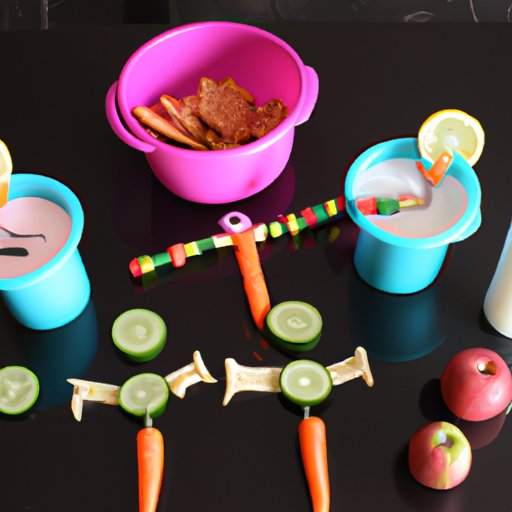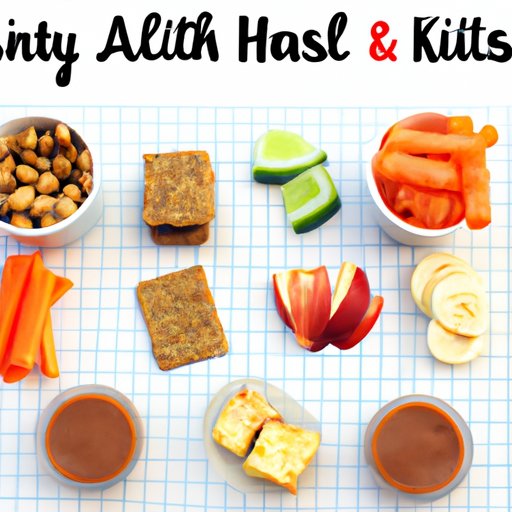Introduction
Snacking is an important part of a balanced diet. Eating healthy snacks throughout the day can give you the energy you need to stay alert and productive, and provide your body with the nutrients it needs for optimal health. But what constitutes a “healthy snack”?
According to the American Heart Association, a healthy snack should be low in saturated fat, added sugar, and sodium, and high in fiber, vitamins, and minerals. It should also provide at least one serving of fruits or vegetables, whole grains, lean protein, or dairy.

List of Healthy Snack Ideas for Adults
When it comes to choosing healthy snacks, the possibilities are endless. Here are some ideas to get you started:
Fruits and Vegetables
Fruits and vegetables make great snacks because they are low in calories and packed with vitamins and minerals. Some examples include apples, oranges, carrots, celery, and cucumbers. You can also try dried fruit, such as apricots and raisins, or frozen fruit like berries and mangoes.
Nuts, Seeds, and Legumes
Nuts, seeds, and legumes are excellent sources of protein, fiber, and healthy fats. Examples include almonds, walnuts, cashews, pumpkin seeds, chia seeds, and edamame. They also contain essential vitamins and minerals, such as iron, zinc, and magnesium.
Whole Grains
Whole grains are an important part of a healthy diet. Try whole-grain crackers, oatmeal, quinoa, or popcorn. Whole grains are rich in fiber, which helps keep you feeling full longer. They also provide essential vitamins and minerals, such as iron, B vitamins, and magnesium.
Dairy and Protein-Rich Foods
Dairy products and protein-rich foods are also good options for snacks. Try yogurt, cheese, hard-boiled eggs, hummus, or Greek yogurt. These foods provide protein, which helps keep you full, and calcium, which is important for strong bones and teeth.
Five Quick and Healthy Snack Recipes
If you’re looking for something a little more exciting than a handful of nuts or a piece of fruit, here are five easy and delicious recipes that use healthy ingredients:
Hummus and Veggies
This classic combo is a great way to get your daily dose of veggies. Simply dip your favorite raw vegetables, such as carrots, celery, bell peppers, and cucumbers, into a store-bought or homemade hummus. Hummus is made from chickpeas, which are a great source of protein and fiber.
Greek Yogurt Parfait
Greek yogurt is a popular snack because it’s high in protein and calcium. To make a parfait, layer Greek yogurt with fresh or frozen fruit and granola. This combination of flavors and textures will satisfy your sweet tooth and keep you full until your next meal.
Avocado Toast
Avocado toast is a simple but delicious snack. Spread mashed avocado on whole-wheat toast, and top with salt, pepper, and any other seasonings you like. Avocados are a good source of healthy fats, which help keep you full and satisfied.
Trail Mix
Trail mix is a great grab-and-go snack. To make your own, combine nuts, seeds, dried fruit, and dark chocolate chips. The combination of crunchy and chewy textures makes this snack both enjoyable and nutritious.
Apple Slices with Peanut Butter
Apples and peanut butter are a classic pairing. Slice an apple and spread natural peanut butter over the slices. This snack provides a balance of carbohydrates and protein, making it a satisfying and healthy choice.
The Benefits of Eating Healthy Snacks
Eating healthy snacks has numerous benefits. Here are just a few:
Improved Energy Levels
Healthy snacks provide your body with a steady supply of energy, which can help you stay focused and productive throughout the day. According to a study published in the journal Nutrients, eating small, frequent meals and snacks can help maintain blood sugar levels and reduce fatigue.
Better Nutrient Intake
Healthy snacks are packed with essential vitamins and minerals. Eating them on a regular basis can help ensure that you’re getting the nutrients your body needs for optimal health.
Reduced Risk of Disease
Eating healthy snacks can lower your risk of developing chronic diseases, such as heart disease, diabetes, and obesity. A study published in the American Journal of Clinical Nutrition found that people who ate healthy snacks were less likely to have high blood pressure and cholesterol levels than those who did not.
Weight Loss/Maintenance
Healthy snacks can help you lose or maintain your weight. Eating smaller, nutrient-dense snacks between meals can help prevent overeating and improve your overall diet quality.

How to Make Healthy Snacking a Part of Your Diet
Making healthy snacking a part of your diet doesn’t have to be difficult. Here are some tips for incorporating healthy snacks into your routine:
Meal Planning
Planning your meals ahead of time can help ensure that you’re always prepared with healthy snacks. Start by writing down a list of healthy snacks you enjoy, and then plan out when you’ll eat them during the week.
Preparing in Advance
Preparing snacks in advance is a great way to save time and stay on track with your healthy eating goals. Cut up fruits and vegetables the night before, or make a batch of trail mix to last multiple days.
Making Substitutions
If your go-to snacks aren’t so healthy, try substituting them with healthier alternatives. For example, swap potato chips for kale chips, or ice cream for frozen banana slices.

The Best Healthy Snacks for Kids
Kids need healthy snacks, too! Here are some ideas for nutritious snacks that your children will actually enjoy:
Fresh Fruit
Fruit is a great snack for kids because it’s naturally sweet and easy to eat. Try sliced apples, bananas, strawberries, or whatever else your child likes.
Popcorn
Popcorn is a great snack for kids because it’s low in calories and high in fiber. Try air-popped popcorn without butter or oil for a healthier option.
Cheese Cubes
Cheese cubes are a fun and tasty snack for kids. They’re a good source of protein and calcium, and they’re easy to take on the go.
Yogurt
Yogurt is a great snack for kids because it’s packed with calcium and protein. Try plain yogurt with fresh fruit or granola for a nutritious and delicious snack.
Peanut Butter and Celery
Celery sticks with peanut butter is a classic snack that kids love. Peanut butter is a good source of protein and healthy fats, while celery provides fiber and hydration.
Shopping Tips for Healthy Snacks
When shopping for healthy snacks, it’s important to read labels and look for whole ingredients. Here are some tips to keep in mind:
Read Labels
Take the time to read nutrition labels before purchasing snacks. Look for snacks that are low in saturated fat, added sugar, and sodium, and high in fiber, vitamins, and minerals.
Look for Whole Ingredients
Choose snacks made with whole ingredients, such as whole grains, fruits, vegetables, and nuts. Avoid processed snacks that contain refined sugars and additives.
Avoid Added Sugar and Sodium
Added sugar and sodium can add unnecessary calories and increase your risk of chronic diseases. Look for snacks that are naturally sweetened with fruit juice or honey, and that contain no more than 200 milligrams of sodium per serving.
Conclusion
Eating healthy snacks is an important part of maintaining a balanced diet. Healthy snacks provide your body with essential vitamins and minerals, improve your energy levels, and can help reduce your risk of chronic disease. Making healthy snacking a part of your diet doesn’t have to be difficult. With the right recipes and shopping tips, you can easily incorporate healthy snacks into your daily routine.
(Note: Is this article not meeting your expectations? Do you have knowledge or insights to share? Unlock new opportunities and expand your reach by joining our authors team. Click Registration to join us and share your expertise with our readers.)
